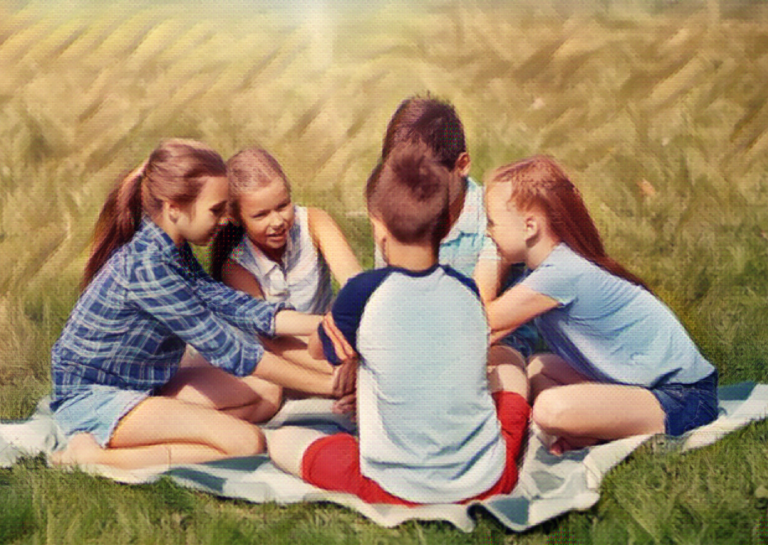Peers play a role in the social and emotional development of children. The influence of others begins at an early age and increases through the teenage years. It is natural, healthy, and important for children to have and rely on their friendships as they grow and mature. Peer influence can be both positive and negative so it’s important to distinguish the difference while your children are young. In this quick tip episode, we discuss when peer pressure can be positive and how you can help your child avoid negative peer pressure.
Table of contents
What is Peer Pressure?
Peer pressure is the direct or indirect influence on people by peers, members of social groups with similar interests, or of certain status. Studies of evolutional biology show that members of a peer group are more likely to influence a person’s beliefs and behavior. Peer pressure isn’t always a negative thing.
Peer Influence Starts Young
When you think of peer pressure you may think of teenagers, drinking, and drugs. But being influenced by the people around us starts much earlier before adolescence. Research has shown that humans learn through watching what others do and following those actions of the majority. Peer pressure is how we learn things early on. This tendency to conform might have provided an evolutionary benefit in terms of decision-making that helped humans learn new skills and avoid dangers.
Peers can be positive and supportive. They can help each other develop new skills, or stimulate interest in books, music, or extracurricular activities. Being influenced by our environment is a part of everyday life.
Benefits of Positive Peer Pressure
Peer pressure can really be a good force in the life of your child and their friends. Positive peer pressure is when someone’s peers influence them to do something positive or growth building. For example, peers who are committed to doing well in school or at sports can influence others to be more goal orientated. Similarly, peers and friends who are kind, loyal, or supportive influence others to be the same.
How to Encourage Your Child to Use Positive Peer Pressure
There are some ways you can guide your child towards positive peer influence. As a parent, you can surround your child with positive adult role models and lead by example. You can also teach them to pay attention to certain qualities in others that would make good friends. One way to teach your child about positive peer pressure is by explaining to them that their behavior is always influencing others. Encourage them to understand that their friends are aware of what other people are doing, just like they themselves are. Explain how they can be of good influence on their friends and what makes their friends a good influence on them.
You can also talk to them about the kind of friends they want to have. Talk with your child about what their values are, and how they can demonstrate them. Encourage them to seek out friends with similar values.
Discouraging Negative Peer Pressure
You can also help them avoid negative peer influence. Friends and family can influence behavior and is often due to wanting to feel like they belong to a group. Negative peer pressure could include your child trying something they may not be interested in or know is wrong as a way to fit into or impress a certain group. Some examples may be smoking or behaving in antisocial ways.
Some common results of peer influence may include: choosing the same clothing as their friends, listening to the same music or television shows, changing the words they use or how they talk, following or breaking rules, working hard at school or not working as hard, and experimenting with substances.
As parents, the best way to discourage your child to follow negative influences is by teaching them that they always have a choice and how to make decisions that align with the person they want to be.
Teaching How to Balance Peer Pressure
It’s normal to worry that your child is being overly influenced by friends or compromising their values to fit in. But remember, listening to the same music as their friends doesn’t mean your child will give into risky behaviors. If your child is confident in who they are and happy with the choices they make, they are less likely to be influenced by others. The best way to help your child to balance peer influence is by building their confidence and helping them identify values that are important to them.
There are ways you can help your child with this. First, you can help them build self-confidence by encouraging them to try new things and helping them persevere when things are hard. Praising your child for trying their best helps build confidence too. Another thing you can do is help them build self-compassion. Being kind to yourself and treating yourself with the same care and understanding as you would others is key. Research shows that healthy levels of self-compassion are shown to help children handle stress and anxiety. Lastly, its important to communicate with your child and keep those lines of communication open. This is done by strengthening your connection to your child and being someone they feel comfortable coming to for advice. We discuss this in our quick tip episode on how to prevent your child from lying to you which is included in the show notes.

